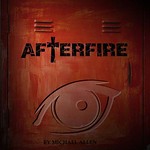Director: Barry Levinson.
Writers: Michael Wallach.
Cast: Kristen Connolly, Jane McNeill, Christopher Denham, Michael Beasley, Kether Donohue, Anthony Reynolds and Andy Stahl.
Director Barry Levinson is no stranger to storytelling. He has a history of telling tales of politics and humour in films such as Good Morning Vietnam and Wag the Dog. In The Bay, Levinson was again motivated to tell a film based somewhat in reality involving the Chesapeake Bay. Fishing and oyster harvesting have declined in the fictional town of Claridge, Maryland. And, there are a treasure trove of monsters to blame. Levinson keeps the real cause of this catastrophe cloaked in fog, but this director's archaeological viewpoint keeps the visual presentation interesting and sometimes macabre.
The film begins with a very normal July 4th celebration in Anytown, USA. Families come together for chicken wing eating contests, fireworks and pool parties. But, there is something growing in the water. A couple of biologists disappeared six weeks before the main events in the film. Their bodies were covered in bite marks. Now, more people are turning up dead.
Most victims learn they are in trouble when they find a rash covering their body. But, this is not a rash. These bumps are the actual beginnings of isopod larvae, which will soon eat the host from the inside out. This is horrifying storytelling at its bloody best.
Levinson covers all of this terror from an archaeologist's viewpoint. Levinson admits, in an interview with Fangoria, that he wanted to approach the film after the events. All of the reels for the film have been collected by a local journalist after the disaster. She wants to spread the word on what has happened in her small town. Thus, the film is told through a series of different formats including: CCTV, text messages, e-mail, Skype transmissions, handheld cameras and dashboard cameras. There truly is an assortment of storytelling devices used in this film and they are used effectively.
This director is effective in his storytelling approach because of his motivation. Levinson actually has a property near Chesapeake Bay. This body of water, as mentioned, is struggling. Much of the bay is polluted and uninhabitable to fish. Thus, Levinson chose to make this film in order to open the audience's eyes to the potential destruction of real life aquatic habitats. The Bay gets this message across in dramatic fashion.
There really is only one question left unanswered in this film; what caused the release of so many waterborne monsters? The film alludes to nuclear radiation contamination. A local nuclear reactor inadvertently spilled some of its contaminants into the local water. As well, there is a lot of focus spent on chicken manure. Millions of pounds of this steroid filled fertilizer are dumped into the bay around Claridge. Did these dumpings create for the problems in the town? The answer to this question is not answered directly, but environmental disasters rarely have one problem and one solution. The Bay addresses these gray areas by not focusing on a cause for the disaster, which keeps the story mysterious.
The Bay is an excellent and chaotic found footage styled horror film. From disappearing deputies to bodies turning up in the road, there is a lot to take in. The Bay moves along at a quick pace, so the chaos increases exponentially. A lot of this chaos occurs in the town's main hospital. It is full of patients looking for help early, but later the halls are full of corpses and red eerie lighting. All of these scenes are filmed with a versatile approach to filmmaking: from camera phones to overhead surgical cameras. In fact, this film used at least twenty camera to create the film's diverse visual style (Fangoria). The chaos and the personal coverage of events are two of The Bay's strongest elements. Both of these elements amplify the film's drama.
Released on video-on-demand November 2nd, this title is one of the best horror films to come out this year. The film's premise is loosely based on reality; isopods do inhabit the Pacific and Atlantic Oceans. As well, Chesapeake Bay is experiencing an increase in pollutants. These elements of non-fiction are then expanded upon in a found footage fictional way to create for the film's many terrifying moments. Levinson continues to bring a political stance to his tales. And The Bay is one of only a few horror films released this year whose purpose is both to entertain and to educate audiences on the potential of looming biological disasters.
Overall: 7.75 out of 10.
An interview with director Barry Levinson is hosted below. In this interview, Levinson's talks about his motivations behind filming The Bay. He also talks about some of non-fiction elements of his story:
Levinson Interview at Fangoria
| |
Advertise Here - Contact me Michael Allen at 28DLA
Subscribe to 28 Days Later: An Analysis Email Subscription
Writers: Michael Wallach.
Cast: Kristen Connolly, Jane McNeill, Christopher Denham, Michael Beasley, Kether Donohue, Anthony Reynolds and Andy Stahl.
Director Barry Levinson is no stranger to storytelling. He has a history of telling tales of politics and humour in films such as Good Morning Vietnam and Wag the Dog. In The Bay, Levinson was again motivated to tell a film based somewhat in reality involving the Chesapeake Bay. Fishing and oyster harvesting have declined in the fictional town of Claridge, Maryland. And, there are a treasure trove of monsters to blame. Levinson keeps the real cause of this catastrophe cloaked in fog, but this director's archaeological viewpoint keeps the visual presentation interesting and sometimes macabre.
The film begins with a very normal July 4th celebration in Anytown, USA. Families come together for chicken wing eating contests, fireworks and pool parties. But, there is something growing in the water. A couple of biologists disappeared six weeks before the main events in the film. Their bodies were covered in bite marks. Now, more people are turning up dead.
Most victims learn they are in trouble when they find a rash covering their body. But, this is not a rash. These bumps are the actual beginnings of isopod larvae, which will soon eat the host from the inside out. This is horrifying storytelling at its bloody best.
Levinson covers all of this terror from an archaeologist's viewpoint. Levinson admits, in an interview with Fangoria, that he wanted to approach the film after the events. All of the reels for the film have been collected by a local journalist after the disaster. She wants to spread the word on what has happened in her small town. Thus, the film is told through a series of different formats including: CCTV, text messages, e-mail, Skype transmissions, handheld cameras and dashboard cameras. There truly is an assortment of storytelling devices used in this film and they are used effectively.
This director is effective in his storytelling approach because of his motivation. Levinson actually has a property near Chesapeake Bay. This body of water, as mentioned, is struggling. Much of the bay is polluted and uninhabitable to fish. Thus, Levinson chose to make this film in order to open the audience's eyes to the potential destruction of real life aquatic habitats. The Bay gets this message across in dramatic fashion.
There really is only one question left unanswered in this film; what caused the release of so many waterborne monsters? The film alludes to nuclear radiation contamination. A local nuclear reactor inadvertently spilled some of its contaminants into the local water. As well, there is a lot of focus spent on chicken manure. Millions of pounds of this steroid filled fertilizer are dumped into the bay around Claridge. Did these dumpings create for the problems in the town? The answer to this question is not answered directly, but environmental disasters rarely have one problem and one solution. The Bay addresses these gray areas by not focusing on a cause for the disaster, which keeps the story mysterious.
The Bay is an excellent and chaotic found footage styled horror film. From disappearing deputies to bodies turning up in the road, there is a lot to take in. The Bay moves along at a quick pace, so the chaos increases exponentially. A lot of this chaos occurs in the town's main hospital. It is full of patients looking for help early, but later the halls are full of corpses and red eerie lighting. All of these scenes are filmed with a versatile approach to filmmaking: from camera phones to overhead surgical cameras. In fact, this film used at least twenty camera to create the film's diverse visual style (Fangoria). The chaos and the personal coverage of events are two of The Bay's strongest elements. Both of these elements amplify the film's drama.
Released on video-on-demand November 2nd, this title is one of the best horror films to come out this year. The film's premise is loosely based on reality; isopods do inhabit the Pacific and Atlantic Oceans. As well, Chesapeake Bay is experiencing an increase in pollutants. These elements of non-fiction are then expanded upon in a found footage fictional way to create for the film's many terrifying moments. Levinson continues to bring a political stance to his tales. And The Bay is one of only a few horror films released this year whose purpose is both to entertain and to educate audiences on the potential of looming biological disasters.
Overall: 7.75 out of 10.
An interview with director Barry Levinson is hosted below. In this interview, Levinson's talks about his motivations behind filming The Bay. He also talks about some of non-fiction elements of his story:
Levinson Interview at Fangoria
| |
Advertise Here - Contact me Michael Allen at 28DLA
Subscribe to 28 Days Later: An Analysis Email Subscription


 Monday, November 05, 2012
Monday, November 05, 2012
 Michael Allen
Michael Allen




 Posted in:
Posted in: 


0 comments:
Post a Comment